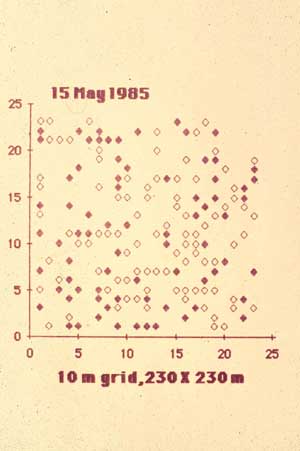|
|
 66 what does trapping say? DHJanzen100581.jpg high resolution
|
|
| The trap results in the same plot as DHJanzen100580.jpg above, on the night of 15 May 1985, 12 days later. Same traps, same bait, same method, same place. Has there been a pulse of immigration into the plot? A great flush of newly fledged young? No, what has happened in those 12 days is that the moon has gone from full moon to nearly the dark of the moon, and the season has gone from the full end of the dry season, to the full rainy season. In other words, the forest friendliness to a foraging Liomys mouse - snuffling through the litter for seeds and moth pupae - has gone from very unfriendly to very friendly, with a resultant great increase in the number of mice foraging above the ground. I should add that these 166 mice are still only 60% of the 275 mice known to be living in this particular sample plot at the time of trapping. What is wrong with the full moon? The owls and cats can see you. What is wrong with the dry season? Even a tiny mouse makes a very evident noise in moving through and over dried leaves on the forest floor. And the lack of foliage in the dry season makes it easier to see at a distance in the forest (contrast image DHJanzen100582.jpg and DHJanzen100583.jpg below) and allows unmuffled transmission of the sound of a foraging mouse. Small wonder that tropical owls in dry forest nest in the dry season (and that north temperate owls nest in the winter). | ||
back to lecture slides
or skip to: